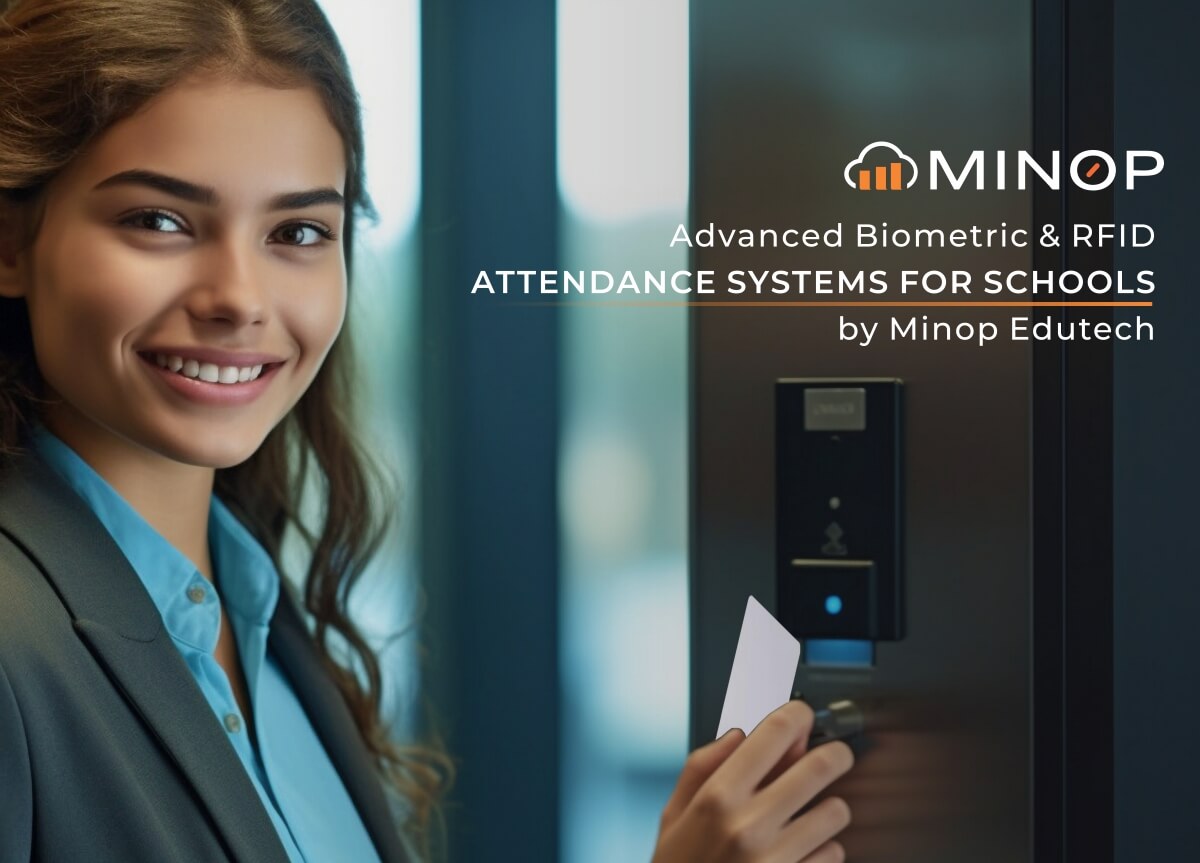Advanced Biometric and RFID Attendance Systems for Schools by Minop Edutech
Posted On:- 21 June, 2024 By:- Arjun Singh
Automated Student Attendance System leverages advanced face recognition technology to offer a more effective solution than traditional fingerprint machines. Fingerprint machines often struggle with the frequently changing fingerprints of young children, leading to inaccuracies and inefficiencies in attendance tracking.
Biometric Attendance Systems for Students
Biometric attendance systems utilize physiological or behavioral characteristics to identify individuals, ensuring precise and efficient attendance recording. These systems employ various technologies, such as:

Fingerprint Recognition:
Scans and matches fingerprints to identify students. However, this method can be less effective for younger children due to their developing fingerprints.

Facial Recognition:
Uses the unique features of a student's face for identification, offering a contactless and reliable solution.

Iris Recognition:
Scans the unique patterns in the colored part of the eye, providing a highly accurate method of identification.

Voice Recognition:
Analyzes vocal characteristics for identification, though less commonly used in school attendance systems.
These biometric systems eliminate the possibility of proxy attendance and errors caused by manual tracking. They can be integrated with a school's existing student information system to streamline the attendance tracking process, ensuring accurate and timely reporting.
RFID School Attendance System in India
RFID (Radio Frequency Identification) technology employs unique identification codes for each student to track attendance. RFID systems offer several advantages:

No Line-of-Sight Issues:
RFID readers can capture tag IDs from a distance, even if there are obstacles between the reader and the tag.

Automatic Scanning:
RFID readers automatically detect and log attendance as students pass by, reducing the need for manual intervention.
However, RFID systems have some limitations, such as difficulty scanning through metal and the potential for tag collisions when multiple tags are read simultaneously.
UHF RFID Attendance System
UHF (Ultra-High Frequency) RFID systems can capture attendance from a distance of 15-20 meters, marking attendance as students enter the school premises. This system offers several benefits:

Automatic Attendance Marking:
Attendance is recorded as soon as students enter the school, minimizing the chances of missed or incorrect entries.

Multiple Reader Integration:
Several readers can be attached to a controller to identify UHF cards carried by students, ensuring comprehensive coverage.

Real-Time Updates:
Integration with time and attendance software allows for the generation of real-time reports, which can be used by schools and parents. Bulk SMS systems can send notifications about students' arrival times or absences.
Face Recognition Technology
Face recognition technology addresses the issue of proxy attendance. By registering students' faces, the system can accurately mark attendance as students come into view of the machine. Schools can install face recognition machines tailored to students' heights and place them strategically to minimize queuing time.
Benefits of Biometric Attendance Systems
Biometric attendance systems offer numerous advantages for educational institutions:
Accurate Attendance Tracking:
Eliminates the possibility of proxy attendance or errors caused by manual methods.

Time-Saving Automation:
Reduces the time teachers and administrative staff spend on attendance tracking.

Cost-Effective:
Minimizes the need for paper-based systems, reducing associated costs.

Real-Time Reporting:
Provides immediate access to attendance data, helping monitor student attendance patterns and identify potential issues.

Enhanced Security:
Ensures only authorized students can access the institution's facilities.

Reduced Workload:
Automates attendance tracking and record-keeping, easing the administrative burden on staff.

Increased Accountability:
Ensures students are present and participating in academic activities, promoting better attendance habits.
Choosing Minop Edutech
Minop Edutech offers state-of-the-art student biometric attendance systems, ensuring efficient and accurate attendance management. Our solutions leverage the latest in biometric technology to provide reliable, secure, and cost-effective attendance tracking systems tailored to meet the needs of educational institutions. Trust Minop Edutech to deliver the best in class attendance solutions, enhancing the overall efficiency and security of your school's attendance management process.

Comments